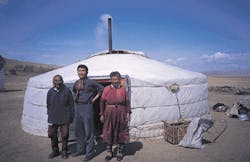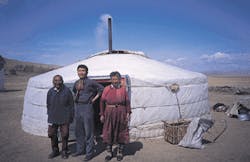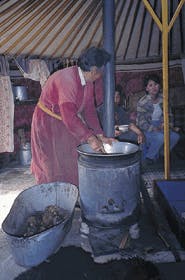A summer in Mongolia
When she brought today`s oral hygiene techniques to Mongolia, the author discovered a learning experience - and not just for her students.
Jennifer Ehrich, RDH
Mongolia is a landlocked nation of 2.4 million people and over 23 million head of livestock, located in Central Asia. Siberia lies to the north and China is located to the south. The nomadic Mongolian people produced Genghis Khan in the 12th century. Genghis and his followers claimed as their empire most of Asia and much of Europe. More recently, in 1921, the Mongols staged their own version of the Bolshevik Revolution and allied themselves with the Russians. For 70 years, Mongolia was a mysterious blank spot on the map for most Westerners. In the late 1980s, the Russians left, a surging democracy movement peacefully toppled the Communist government, and Mongolia rejoined the world community.
I was fortunate to be able to spend two summers in Ulaanbaatar, Mongolia`s capital city, where my sister was working as a Peace Corps medical officer. Her work with local nursing education piqued my interest in doing an internship there as part of my dental hygiene program at the University of New England, Westbrook Campus, located in Portland, Maine. Mrs. Ellen Beaulieu, my dental hygiene program director, shared my enthusiasm, and so the idea of an oral-assessment seminar for Mongolian nurses and dental nurses was born.
Dental care in Mongolia exists much as it did in the United States more than 50 years ago. Extractions and basic restorations are the mainstays of dental practice. Oral hygiene, other than basic toothbrushing, is a foreign concept. There are no dental hygienists in Mongolia. Nurses who have additional training as basic dental assistants assist dentists. As a result, many Mongolians are plagued with poor oral health. They are well aware of the problem, but not how to treat it.
The summer of 1997 seminar internship was initially planned as a 45- to 60-minute in-service program geared to dental-care professionals in Mongolia. Preparatory work included shipping several boxes of toothbrushes, toothpaste, dental floss, disposable mouth mirrors, gloves, and disclosing solution to Mongolia. My sister made contact with several Mongolian dentists and their assistants, and they expressed interest in such an in-service program.
Upon my arrival inUlaanbaatar, I was able to procure as translator, assistant, and all-around invaluable asset, Ms. Gangatuul. (Mongolians only have one name.) She worked with my sister at the Peace Corps Health Unit. She had worked extensively in nursing education, so she was familiar with health-care terminology. She and I worked diligently to conduct a needs assessment and to select a target population for the in-service program.
It quickly became evident that the planned 45-minute in-service program would need to be expanded to a four-to-five-hour seminar. This lengthening of the program was necessary due to the knowledge deficit exhibited by our target audience, as well as the extra time needed to have the lecture and explanations translated from English into Mongol. No material was available in the Mongolian language pertaining to oral hygiene and assessment for health-care providers or laypersons. We needed to develop a teaching plan, class handouts, and patient education materials in English and then have them translated into Mongol. One of my goals was to leave the seminar participants with enough printed information in their language that they could conduct future seminars for their colleagues and for patient-education purposes.
In addition to oral hygiene and assessment techniques, I included information on universal precautions. This was another concept that had not yet been introduced to Mongolia on a wide scale. The Russian health-care model had not adopted this philosophy and practice. Add to that the lack of resources in this poor country and it became obvious why it was difficult for the practice of adequate infection control to gain acceptance. Yet, it is vitally important that universal precautions be taught, practiced, and reinforced in the dental arena. Although HIV infection currently is at a low rate in Mongolia, hepatitis B is rampant, with most of it having been spread iatrogenically via inadequately sterilized, reusable hypodermic needles and other medical practices.
The planning phase also included the establishment of a working relationship with two highly respected Mongolian dentists. One was Dr. Sainbilieg, the assistant director of a dental clinic that operated under the sponsorship of Yonsei University in South Korea. The second dentist - and the one I had the most contact with - was Dr. Naranbyamba, a revered dental professor at the Dental University.
The seminar
After a great deal of work and "fine-tuning," our presentation was ready. The seminar would be given 12 separate times, with several hundred Mongolian nurses, dental nurses, physicians, and dentists in attendance.
The "Oral Hygiene and Assessment for Health-Care Professionals in Mongolia" seminar would take place over a two-day period, with each session lasting two to two-and-a-half hours in length. An outline and handouts were distributed to the participants.
Pre- and post-tests were given to all of the attendees. This was yet another new concept to those people, who had received their education based on the Soviet model. The idea of taking a test that they were not graded on - and which was intended to help the instructor improve class-material content and the presentation of the material - was difficult for many of them to understand.
Universal precautions and infection-control theory, rationale, and practice were taught and discussed. The discussion covered how these precautions could be put into practical use in Mongolia, given the lack of resources. Frequent hand-washing, hand-washing between patients, and proper disposal of medical waste were identified as procedures that could be adhered to in Mongolia. Participants were encouraged to voice their concerns about their own safety and that of their patients to their facility administration and the Ministry of Health.
Another topic covered in the seminar was "The Theory and Rationale of Oral Hygiene." For this part of the presentation, I created a full-color, patient-education brochure in the Mongol language that I distributed to the attendees. Through use of the brochure, handouts, flip charts, and photographs, the participants were introduced to what a normal oral cavity should look like. They also were introduced to the progression of gum disease, starting with gingivitis and continuing through the various degrees of periodontal disease.
Proper brushing and flossing were demonstrated using a typodont, a large toothbrush, and floss. Very few participants were aware of what dental floss was. We heard that it could be found from time to time in the local market, but that people did not understand its purpose. They would use it for sewing together the heavy canvas covers to go over the traditional Mongol dwellings (called gers or yurts).
Because alcohol and tobacco use is widespread in Mongolia, an introduction to five common oral neoplasms was included in the seminar. The participants found the photographs of these neoplasms very interesting. This would set the stage for the next day`s session, during which oral-assessment rationale and techniques would be discussed.
Day two of the seminar consisted of a practicum of oral hygiene, with a return demonstration by all the participants. The toothbrushes, toothpaste, floss, and dental mirrors were dispersed to the participants, and each one took his or her turn using the disclosing solution and then using the various oral hygiene skills that had been taught.
The participants also were given disposable gloves, tongue blades, gauze pads, and a light source. They were taught how to conduct a basic extra- and intraoral assessment. Each would give a return demonstration and explain the rationale of such an exam.
Other important areas that were addressed in the seminar were the importance of proper referral of detected pathologies and the importance of patient education. The latter was another area that had been neglected under the Soviet model. Patients are not viewed as integral members of the health-care team and, as such, are not offered explanations, rationale, and choices regarding their treatments.
Each of the two days concluded with a question-and- answer period. I was struck repeatedly by the enthusiasm and outright excitement demonstrated by the seminar participants for the material I presented. Many of the questions from them reflected their curiosity about life in America.
In addition to the formal seminar, Dr. Naranbyamba requested that I demonstrate an assessment and cleaning on a patient in her clinic at the Dental University. This would enable her, the dental nurses, and other clinical personnel to observe firsthand this sort of exam. Dr. Naranbyamba hoped that viewing this demonstration would help facilitate the practice on a regular basis in the dental clinic. The major points I hoped to illustrate through the exam included:
- Sanitation/infection control
- Charting, including health history and other documentation typically carried out by dental hygienists
- Systematic exam - extra- and intraoral exam
- Use and proper cleaning of instruments
Teaching techniques
Finding the most effective teaching techniques to use in the seminar was a case of trial and error. I was initially uncertain whether the subject matter of oral hygiene was going to be of much interest to Mongolian health professionals. The barrier of language, culture, and years of ideological separation between the Soviet and Western models of health and teaching/learning methods were of great concern to me. Here was a group of people who had been trained by a methodology in which large groups of students sat in classrooms listening to lectures and taking a lot of notes. They were discouraged from asking questions or interacting with their instructors or classmates. How would they now react to a learning environment where they were expected to interact, get involved, make mistakes, and ask questions?
I was pleasantly surprised at how quickly the seminar participants adapted to this new style of teaching and learning. I learned that it was necessary to state the same information in several ways during the course of the instruction. It was difficult to know how well the concepts translate directly into the Mongolian language. However, Gangatuul and I soon learned the best way to present the material so that the participants` questions and answers in response to my questions showed they were understanding the material.
We also needed to frequently remind the participants that the seminar was being presented with the intention of them learning the rationale behind the practice. I emphasized that they would not be "graded" or otherwise penalized if their technical skills were not flawless after one or two attempts.
The biggest success in the teaching techniques came from the actual demonstrations and return demonstrations. Gangatuul told me that this probably was the first time that most of the participants had ever received such well-prepared handouts, not to mention the materials with which to perform a procedure. After observing my demonstration, the participants would enthusiastically perform oral exams on one another and, on more than one occasion, some real abnormalities were discovered.
In general, this more open approach to teaching was effective with this population. The handouts provided them the time to absorb the information, rather than trying to write copious notes. The opportunity to watch a clear demonstration for a procedure that they had learned the rationale for and then perform a return demonstration was a real boost to their learning process. This was borne out by the results of the pre- and post-tests, as well as the participant-evaluation responses.
A small amount of literature exists documenting the state of dental health in the developing world. It points to the widespread existence of unacceptably high levels of dental caries, periodontal disease, and oral cancer.
The literature contains even less information regarding the teaching of oral hygiene and assessment in the developing world. There is some data from China that suggests increasing public awareness of oral health can increase toothbrushing behavior and people`s desire to improve their dental health.
Unexpected outcome
The World Health Organization (WHO) and the International Dental Federation have defined global objectives for dental health that allow for monitoring progress in various countries. They have stated that "dental health promotion aims to create an environment favorable to the adoption of ... health behaviors," such as "dental hygiene, nutrition, fluoride intake, and dental-service utilization."
My purpose and desire for undertaking my dental hygiene internship program in Mongolia was to further these goals by educating an important segment of Mongolian society in the importance and practice of oral hygiene and assessment. I finished this project with a sense of satisfaction that my endeavors had opened a door of understanding and given the participants the means to further spread the message to their colleagues and patients.
The unexpected outcome of my internship program was the incredible impact the Mongols had on me. Their intelligence, dignity, humor, and undaunting desire to improve their lot humbled and empowered me at the same time. In the space of four or five hours, the gulf that 70 years of Cold War and isolation had created simply melted away in a flurry of disclosing solution and dental floss.
This experience has only intensified my interest in the furtherance of oral health in developing countries. My challenge goes out to dental hygienists everywhere to become more involved in this endeavor. I would like to see our national hygiene organizations reach out to dental professionals all over the world to form alliances to help establish oral health as a priority in national health-care policies the world over.
Dental hygiene is a profession that we all can feel proud to be a part of. My experience in Mongolia reinforced my belief in the positive influence we can have on people`s quality of life, even in the most unexpected of places.
Jennifer Ehrich, RDH, has made a mid-life career change. Following a life-long dream, she entered a dental hygiene program at the University of New England, Westbrook Campus. This meant having to uproot her home of 10 years in Las Vegas, Nev., and moving to Portland, Maine, for three years. She graduated magna cum laude with an associate`s degree in dental hygiene in 1998. She currently is completing course work toward a bachelor`s degree in dental hygiene, which she will receive in August. Mrs. Ehrich spent most of her childhood living with her family in Liberia, West Africa, where her father worked as an engineer. This began a lifelong interest in travel and, ultimately, working with people from a variety of cultures. She spent the summers of 1996 and 1997 in Ulaanbaatar, Mongolia, in north central Asia, where her sister was working for the Peace Corps. She has returned to Las Vegas, where she is working as a hygienist and taking classes. She divides her professional time between working in private dental offices and the Community Health Center of Nevada. The latter is an agency that provides health-care services to those who otherwise would be unable to afford dental and health care. It also provides her with an opportunity to realize her commitment to the underserved populations of the world. Ms. Ehrich`s biggest dream is to help institute a dental hygiene program in a developing country where the need and desire is great, but the resources are limited.
References
- Bian, J.Y., Zhang, B.X., Rong, W.S. (July 1995). "Evaluating the social impact and effectiveness of four-year `Love Teeth Day` campaign in China." Advances in Dental Research. 9 (2):130-3.
- Cohen, H.D., Fisher, R., Mann, J., Berg, R.G. (June 1995). "Periodontal treatment needs and oral hygiene among Ethiopian immigrants." International Dental Journal. 45 (3):204-8.
- Fossion, E., DeCoster, D., Ehlinger, P. (1994). "Oral cancer; epidemiology and prognosis." Revue Belge de Medecine Dentaire. 49 (10):9-22.
- Mann, J., Cohen, H.S., Fisher, R., Ramari, I., Berge, R.G., Fischman, S.L. (October 1994). "Prevalence of dental caries among Ethiopian immigrants." International Dental Journal. 44(5):480-4.
- Normark, S. (March 1991). "Oral health among 15- and 35-44 year-olds in Sierra Leone." Tandiaegebladet. 95(4):132-8.
- Nielsen, C., Hardy, D. (June 1990). "Hygiene critical in third world." RDH. (10)6:38,40,42 passim.
- Ojofeitime, E.O., Hollist, N.O., Banjo, T., Adu, T.A. (August 1984). "Effect of cariogenic food exposure on prevalence of dental caries among fee and nonfee-paying Nigerian schoolchildren." Community Dentistry & Oral Epidemiology. 12(4):274-7.
- Moller, I.J. (September 1979). "Preventive responses to various national problems." International Dental Journal. 29(3):208-14.
- Peng, B., Petersen, P.E., Fan, M.W., Tai, B.J. (December 1997). "Oral health status and oral health behavior of 12-year-old urban schoolchildren in the People`s Republic of China." Community Dental Health. 14(4):238-44.
- Peng, B., Petersen, P.E., Tai, B.J., Yuan, B.Y., Fan, M.W. (June 1997). "Changes in oral health knowledge and behavior 1987-95 among inhabitants of Wuhan City, PR, China." International Dental Journal. 27(3):142-7.
- Tapsoba, H., Deschamps, J.P. (December 1997). "Promotion of orodental health in adolescents in Africa." Promotion at Education. 4(4):26-8.
- Zheng, T.Z., Boyle, P., Hu, H.F., Duan, J., Jian, P.J., Ma, D.Q., Shui, L.P., Niu, S.R., Scully, C., MacMahon, B. (November 1990). "Dentition, oral hygiene, and risk of oral cancer; a case-control study in Beijing, People`s Republic of China." Cancer Causes & Control. 1(3):235-41.
Three Mongolians pose in front of the traditional Mongol dwelling, called "gers" or "yurts." The dwellings are made so they can be easily torn down and set up in keeping with the Mongol people`s nomadic lifestyle.
A Mongolian woman cooks on her portable stove. At far right is the author`s interpreter, Ms. Gangatuul. The stove is used for cooking year-round and also serves as a heat source for the gers in the winter.
The author, Jennifer Ehrich, RDH (standing), goes over some of the course material with her students. The students are looking to the front of the room where the translator, Ms. Gangatuul, is interpreting what Ehrich is saying.



